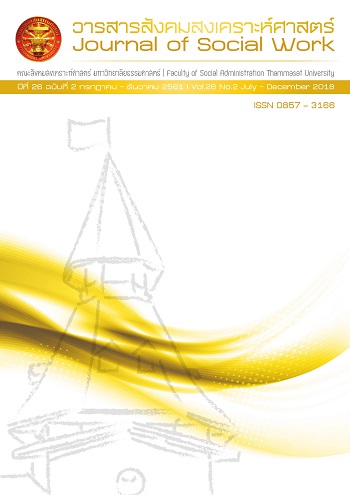Media Literacy of Children and Youth Under the Beauty Discourse of Television Advertising
Keywords:
Media literacy, Beauty discourse, Television advertisingAbstract
The purpose of this research is to study the meaning and meaning of the beauty discourse, and media literacy of girls and young women as recipients of the beautiful television advertising. This research is a qualitative research with an analysis of the advertising with the following features: (1) to advertise products, services or products in terms of whiteness, thinness and youthfulness. (2) It is broadcast on channel 3,5,7,9 most airing during June to December 2012. Focus group interview with 48 girls and young women between 12-18, August to November 2013 in 4 regions of Thailand. The study found that (1) The constructing of the meaning of the beauty discourse in advertising is a reproduction area of beautify discourse that sets a pretty standard of white, skinny and youthful. In addition, the mainstream beauty discourse still presses and blocks the other beauty. (2) Most children define the beauty as well as the presentation of the advertising. While the beauty definition of youth is different from the mainstream beauty in the advertising. The media literacy found that children and youth have access to substances no different and they have the ability to analyze substances identity the elements of the media in the presentation of the media format, content, target audience and presentation techniques. It can also evaluate the credibility of the advertising. The recommendation is to encourage children and youth to have knowledge and skills in media literacy and the ability to create the discourse in society through develop a media literacy curriculum or program based on the age range of each type of media.
References
เกศราพร บำรุงชาติ. (2550). การศึกษาเชิงเปรียบเทียบสาเหตุของการรู้เท่าทันสื่อโฆษณาทางโทรทัศน์ของนักเรียนช่วงชั้นที่ 3 สังกัดกรุงเทพมหานคร ที่มีระดับการคิดอย่างมีวิจารณญาณและระดับการตระหนักรู้ตนเองแตกต่างกัน. วิทยานิพนธ์ปริญญามหาบัณฑิต, มหาวิทยาลัยศรีนครินทรวิโรฒ.
จันทิมา ปัทมธรรมกุล. (2550). วิเคราะห์การสร้างวาทกรรมความงามของโฆษณาผลิตภัณฑ์ที่บำรุงผิว. วิทยานิพนธ์มหาบัณฑิต, มหาวิทยาลัยธรรมศาสตร์.
ทิพวรรณ ถาวรังกูร. (2553). ความรู้เท่าทันโฆษณาแฝงของผู้ชมรายการชิดหมอ ในเขตกรุงเทพมหานคร. วิทยานิพนธ์ปริญญามหาบัณฑิต, มหาวิทยาลัยธรรมศาสตร์.
ไทยรัฐออนไลน์. ห่วง! เด็กไทยติดเน็ต-สื่อใหม่หนึบสถิติพุ่งเผ้าจอ 8 ชั่วโมงต่อวัน. http:// www.thairath.co.th. (2557, 29 กันยายน).
นวพร สิงหพุทธางกูร. (2556). สัญญะ “ผู้หญิงยุคใหม่” ในโฆษณาแฝงบทความนิตยสาร Cosmopolitan ความเป็นผู้หญิงยุคใหม่: บริโภคนิยม. (การค้นคว้าอิสระ ศิลปะศาสตร-มหาบัณฑิต, สถาบันบัณฑิตพัฒนบริหารศาสตร์)
ปริตรตา เฉลิมเผ่า กออนันตกูล. (2551). เผยร่าง-พรางกาย : ทดลองมองร่างกานในศาสนา ปรัชญาการเมือง ประวัติศาสตร์ ศิลปะ และมานุษยวิทยา. กรุงเทพฯ : โครงการจัดพิมพ์คบไฟ.
ปิยรัตน์ ปั้นลี้. (2545). กระบวนการลดความอ้วนของผู้หญิง : วาทกรรมการสร้างอัตลักษณ์ในวัฒนธรรมบริโภค. วิทยานิพนธ์มหาบัณฑิต, จุฬาลงกรณ์มหาวิทยาลัย.
พรทิพย์ เย็นจะบก. (2552). ถอดรหัสลับความคิดเพื่อการรู้เท่าทันสื่อ. กรุงเทพฯ: สำนักพิมพ์ปิ่นโต พับลิชชิ่ง.
พรทิพย์ สัมปัตตะวนิช. (2556). แรงจูงใจกับการโฆษณา. กรุงเทพฯ : สำนักพิมพ์มหาวิทยาลัยธรรมศาสตร์.
เมสิริณ ขวัญใจ. (2551). เด็กกับการรู้เท่าทันสื่อโทรทัศน์. วิทยานิพนธ์มหาบัณฑิต, จุฬาลงกรณ์มหาวิทยาลัย.
สมสุข หินวิมาน. (2544). สื่อโฆษณาในมิติทางวัฒนธรรม. เอกสารประกอบการเสวนามานุษวิทยาสิรินธร. (อัดสำเนา).
เอื้อจิต วิโรจน์ไตรรัตน์. (2540), การวิเคราะห์ระดับมีเดียจิตเตอเรซีของนักศึกษาระดับอุดมศึกษาในประเทศไทย. วิทยานิพนธ์ครุศาสตรดุษฎีบัณฑิต, จุฬาลงกรณ์มหาวิทยาลัย.
อุ่นใจ เจียมบูรณะกุล. (2549). วาทกรรม “ความสวย” และการต่อรองอัตลักษณ์วัฒนธรรมบริโภค. วารสารสังคมศาสตร์, 18(2), 134-167.
Davis, Kathy. (1995). Reshaping the female body: the dilemma of cosmetic surgery. New York : Routledge.
Potter, W.James. (2004). Media Literacy. The United States of America : The McGraw-Hill.
Downloads
Published
How to Cite
Issue
Section
License
The manuscripts published in the Social Work Journal is the copyright of the Social Work Journal, Thammasat University
Any article or opinion appeared in the Social Work Journal will solely be under the responsibility of the author The Faculty of Social Administration, Thammasat University and the editors do not need to reach in agreement or hold any responsibility.



